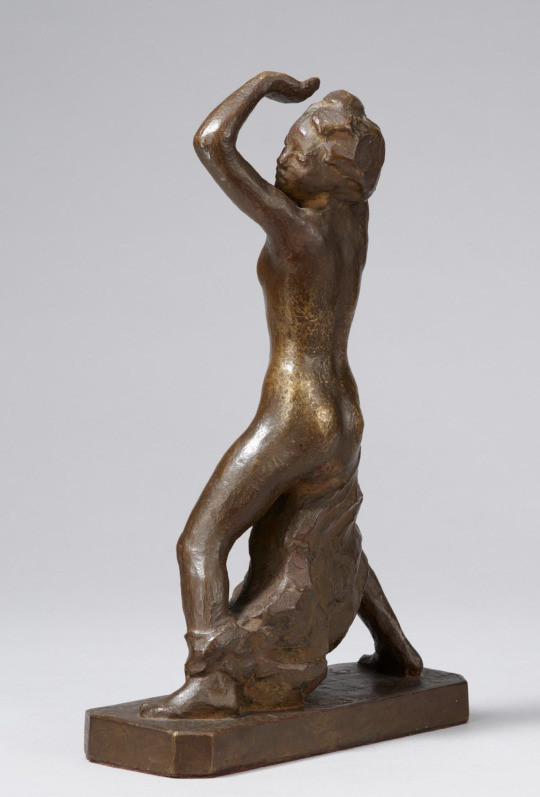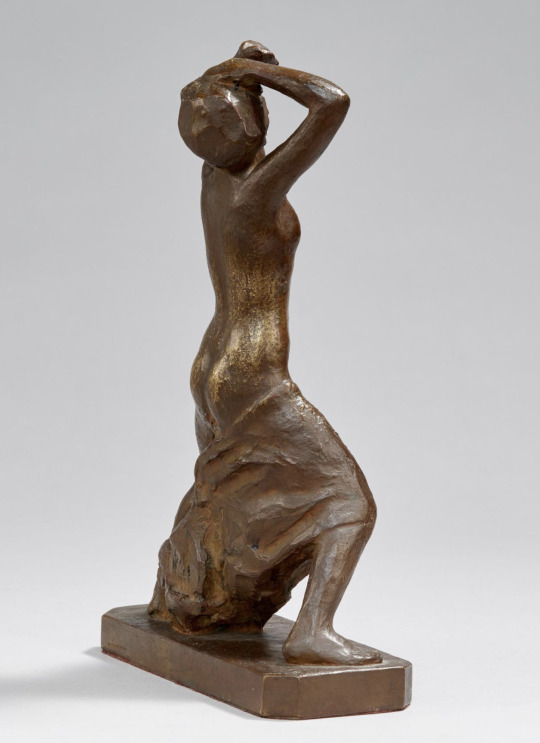#Georg Kolbe
Text

Georg Kolbe (German, 1877-1947)
A Summer Day, 1903
655 notes
·
View notes
Text

Georg Kolbe
Liebespaar, 1910
Photo: Ludwig Schnorr von Carolsfeld
381 notes
·
View notes
Text

Georg Kolbe (German, 1877–1947)
"Tänzerin" ("Dancer"), 1911
V&A
212 notes
·
View notes
Text



Georg Kolbe (1877 -1947) - 'Ringkampf' ou 'Mann und Weib, ca. 1913
64 notes
·
View notes
Text

#peoplematchingartworks#georg kolbe#altenationalgalerie#stefandraschan#photography#contemporaryart#berlin
31 notes
·
View notes
Photo


Georg Kolbe in his Atelier in Rome, 1900
photographer unknown
36 notes
·
View notes
Text

Female Dancer (Tänzerin) (Georg Kolbe, 1911)
12 notes
·
View notes
Text

Georg Kolbe - Ruhender Athlet
1935
5 notes
·
View notes
Text








Wat? Porträt Henry van de Velde (1913) door Georg Kolbe, Ein Damensalon für Editha Freifrau von Münchhausen, Ein Speisezimmer – Alfred und Hanna Wolf beide, Wintersonne ((1892), Teekleid (ca. 1896), Speizeservice (1903/1904) en Besteckserie Modell I (na 1902), Bucheinband Friedrich Nietzsche ‘Also sprach Zarathustra’(1914), Kompartiment aus dem Frisiersalon François Bary (ca. 1901) en Entwurf Grossherzogliches Museum für Kunst und Kunstgewerbe Weimar (1903/1904), alles ontworpen (en Wintersonne gemaakt) door Henry van de Velde (Teekleid samen met Maria van de Velde)
Waar? Museum Neues Weimar, Weimar
Wanneer? 29 juli 2024
Met de komst van groothertog Wilhelm Ernst (1876-1923) ging er in Weimar een nieuwe wind waaien, niet in de laatste plaats waar het de kunst betrof. De nieuwe groothertog zette de deur open voor een beweging die trachtte Weimar een vernieuwende rol te geven in de kunsten, zoals in de tijden van Goethe en Liszt. Het initiatief werd genomen door een trio, bestaande uit Harry Graf Kessler, Elisabeth Förster-Nietzsche en Henry van de Velde.
Harry Graf Kessler (1868-1937) was een metropoliet en een veelzijdig man met een grote voorliefde voor kunst. Elisabeth Förster-Nietzsche (1846-1935) was de zus van filosoof Friedrich Nietzsche, wiens werk ze na zijn geestelijke ineenstorting zou uitgeven. Daarbij aarzelde ze niet de tekst hier en daar aan te passen aan de antisemitische denkbeelden die ze deelde met haar man. De Belg Henry van de Velde (1863-1957) tenslotte was architect, ontwerper, vormgever en schilder. Hij verzette zich tegen het kopiëren van historische stijlen en liet zich inspireren door de Engelse Arts and Crafts-beweging. Hij verhuisde in 1899 naar Duitsland. Samen met Kessler werd hij grondlegger van de Kunstgewerbeschule in Weimar, de voorloper van het Bauhaus.
Ik ken Henry van de Velde met name als ontwerper van meubelen. In Museée d’Orsay in Parijs staat bijvoorbeeld een prachtig halfrond bureau dat door hem is ontworpen. Dat Van de Velde aanzienlijk veelzijdiger is dan alleen meubelontwerper wordt duidelijk in dit museum in Weimar. Ook hier volop meubelen die door hem zijn ontworpen. Naast individuele meubelen toont het museum ook de inrichting van een damessalon voor Editha Freifrau von Münchhausen en van een eetkamer voor Alfred en Hanna Wolff. Maar er hangt ook een pointillistisch schilderij van zijn hand (Wintersonne), er is een jurk te zien die door hem is ontworpen, er is door hem ontworpen servies en bestek en er is een boekomslag voor Nietzsche’s Also sprach Zarathustra dat door Van de Velde werd ontworpen. En dan is er nog een werkelijk prachtig compartiment met kappersstoel uit de kapsalon van François Haby in Berlijn.
Van de Velde was ook actief als architect. Hij ontwierp enkele tientallen gebouwen in Weimar waaronder het museum waar ik al het zojuist genoemde bewonder: het Grossherzogliche Museum, tegenwoordig het Museum Neues Weimar.
0 notes
Text
After the war, Breker’s status as image maker for the Nazis, one might have thought, would have made him persona non grata in the new German republic. On the contrary, he benefited from an old boys’ network of Nazis: his Pallas Athene in Wuppertal was made possible by the intercession of fellow “divinely gifted” architect Friedrich Hetzelt.
Despite being fired as professor of visual arts in Berlin after being named as a Nazi fellow traveller in 1948, Breker went on to thrive professionally, designing sculptures for Dusseldorf’s city hall. He also made busts of political leaders including Konrad Adenauer, the Federal Republic’s first chancellor. True, when the Pompidou Centre in Paris in 1981 staged a Breker retrospective there were protests from anti-Nazi activists. Four years later though, his posthumous reputation was boosted when the Schloss Nörvenich was given over to an Arno Breker Museum that can still be visited today.
Breker was not an unusual case. The Deutsches Historiches Museum exhibition includes more than 300 works of art – tapestries, murals, sculptures – made by Nazi artists or fellow travellers after 1945. Among them is work by Hermann Kaspar whom Speer commissioned to design mosaics, frescoes, floors, friezes and wood inlays for the New Reich Chancellery. Hitler was most taken with the inlay of the oversized desk in the Führer’s study that, Speer recalled in his memoirs, depicted the mask of Mars, god of war, behind which a sword was crossed with a lance. “Well, well,” Hitler reportedly told Speer. “When the diplomats sitting in front of me at this table see it, they will learn to be afraid.”
After the war, Kaspar received numerous state commissions, including the national coat of arms tapestry in the Senate Hall of the Bavarian state parliament. Most strikingly, though, Kaspar finished work he had started under the Third Reich. He began his monumental wall mosaic for the Congress Hall of Munich’s German Museum in 1935, finally completing it in 1955.
Kaspar’s postwar success bears out a remark made by the great German Jewish philosopher Max Horkheimer when he returned from American exile to the University of Frankfurt in the late 1940s. “I attended a faculty meeting yesterday and found it too friendly by half and enough to make you throw up,” he wrote. “All these people sit there as they did before the Third Reich. Just as if nothing had happened … they are acting out a Ghost Sonata that leaves Strindberg standing.”
Brauneis agrees with this assessment: “In West Germany and Austria, if not East Germany, many of the most successful artists were Nazis.” The ghost sonata carried on as if the Holocaust had not happened. Brauneis’s exhibition is aimed at bringing a neglected chapter in German history to light.
The official version, after all, is that West Germany was no haven for Nazis and that after 1945 a radical new aesthetic emerged. Indeed, a parallel exhibition at the museum tells the history of Documenta, the contemporary art show that takes place in Kassel every five years. When federal president Theodor Heuss opened the first Documenta in 1955, artists who had flourished in the Nazi era were not allowed to exhibit there since they were deemed unsuited to the modernist, anti-Nazi self-image of the young republic.
Brauneis argues that the hidden history he unveils undermines that flattering image. “The truth is that these ‘divinely gifted’ artists had close ties with the cultural-political programme of the Federal Republic.”
Consider Willy Meller. He had created sculptures for Berlin’s Olympic stadium, and others for the Nazis’ Prora holiday resort. After the war, Meller thrived professionally, making sculptures for the German postal service, a federal eagle for the Palais Schaumburg in Bonn, then the official residence of the Federal Chancellor. Meller even sculpted a work called The Mourning Woman for the Oberhausen Memorial Hall for the victims of National Socialism, which opened in 1962. “When The Mourning Woman was unveiled,” says Brauneis, “nobody seemed to notice that a ‘divinely gifted’ artist had been commissioned to make a sculpture for a centre devoted to recording Nazi crimes.”
Indeed, Brauneis points out that when there were objections in the press or among art critics to publicly commissioned art in West Germany, their complaints rarely had anything to do with the artists’ Nazi credentials. Rather, what united critics, press and public alike was hostility to modern art in the public sphere.
It is as if the dismal dialectic set up by Goebbels in Munich in 1937 – on the one hand heroic, neoclassical German art sanctioned by the Nazis, and on the other modern art made by Jews and “degenerate” foreigners that often ended up being burned by Nazi functionaries – was still playing out in the first decades of West Germany’s existence.
Dissenting voices finally emerged. But what’s especially striking is how much of the postwar work of these Nazi artists survives, barely noticed, in public spaces in Germany. Raphael Gross, the Deutsches Historisches Museum’s president, recalls that when he lived in Frankfurt he would pass by a sculpture every day on his way to work at the city’s Rothschild Park. “Until recently, I didn’t know it had been commissioned during the Third Reich and installed after the war.”
The park, named after the Rothschild family who had bought the property in 1837, was appropriated by the Nazis and its palace destroyed in a 1944 RAF bombing raid. Today, the park includes a statue called Der Ring der Statuen depicting seven nude allegorical figures by Georg Kolbe, commissioned in 1941 but only erected in 1954.
How odd that a park that only after the war reverted to the Jewish name the Nazis had erased could today display a sculpture by one of Hitler’s favourite artists. In 1939, Kolbe created a portrait bust of the Spanish dictator Francisco Franco, which was given to Hitler as a birthday present. Kolbe, to be fair, was one of the few Third Reich artists to have work shown in both Munich’s Degenerate Art show and the Nazi-sanctioned Große Deutsche Kunstausstellung across town.
What should be the fate of these sculptures, tapestries and murals made by Nazis and fellow travellers? Should they be destroyed, retired from public view or just contextualised with helpful labels? The first option, I suggest to Gross and Brauneis, should not be ruled out. After all, there is a rich history of destruction of public art. In 2003, a weightlifter took a sledgehammer to the giant statue of Saddam Hussein in Baghdad. During the so-called Leninfall in 2014, some of the 5,500 statues of Lenin were pulled down in Ukraine. When last year the statue of slave trader Edward Colston was thrown into Bristol’s dock, historian David Olusoga wrote in the Guardian: “[T]his was not an attack on history. This is history. It is one of those rare historic moments whose arrival means things can never go back to how they were.”
Gross and Brauneis think the issue is less clear cut in the German case. “We must go case by case,” says Gross. “There can’t be a general rule.” Brauneis argues that in some cases explanatory notes are enough. “Sometimes rather than destroying the past we have to learn about it and then live with it even if that is uncomfortable.”
#studyblr#history#military history#art#art history#sculpture#architecture#racism#antisemitism#politics#german politics#ww2#holocaust#documenta#degenerate art exhibition#germany#nazi germany#west germany#ussr#ukraine#arno breker#friedrich hetzelt#hermann kaspar#adolf hitler#max horkheimer#wolfgang brauneis#willy meller#joseph goebbels#raphael gross#georg kolbe
1 note
·
View note
Note
the real question is how is st raphael losing to the patron saint of england?
IMHO it's because people love a good legend. St George the human dragon slayer vs St Raphael the angel dragon slayer?
Let me reply with one of my favorite quotes from St Maximilian Kolbe:
“If angels could be jealous of men, they would be so for one reason: Holy Communion.”
-St. Maximilian Kolbe
I too would rather be human than angel!!
9 notes
·
View notes
Text

Georg Kolbe
Brunnenentwurf mit liegender Frau I (Fountain design with lying woman I), 1914
Source
26 notes
·
View notes
Text

Georg Kolbe's "Morning" in Ludwig Mies van der Rohe's Barcelona Pavilion, 1925
Photograph by Cami Stone
Georg Kolbe Museum
17 notes
·
View notes
Text




Georg KOLBE (1877 - 1947) - Petite Amazone, 1911/12
30 notes
·
View notes
Photo


Georg Kolbe - Tänzer Nijinsky (1914)
26 notes
·
View notes
